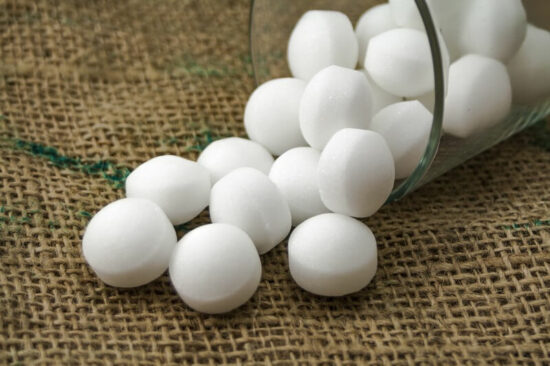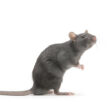Due to their frequent use for pests over the years, it’s only natural that homeowners would wonder if mothballs can keep cats away too!
This guide explains everything you need to know about using mothballs to repel cats, and some of the drawbacks you should consider before using them.
Table of Contents
Do Mothballs Keep Cats Away?
Whether you’re dealing with a feral cat or someone’s spoiled house cat who likes to roam the neighborhood, keeping these felines out of your garden isn’t easy. Cats like to invade gardens for a variety of reasons. It could be because they’re interested in what you’re growing, they want to claim the territory, use the soft soil as a litter box, and more.
Whatever the case may be, cats have been bothering gardeners for ages! As a result, you might have heard a few old wives’ tales and tricks to deal with this unique problem. One example is using mothballs.
Mothballs are a staple in many homes. Traditionally, you’re supposed to put them in closets and wardrobes. A solid form of pesticide, mothballs can help deter fiber-eating pests as you store your clothes away for months. You’re most likely to see them tossed around storage spaces for winter or summer attire in the off-season.
These little white balls are cheap, accessible, and easy to use. While their purpose and application are straightforward, gardeners of yesteryear used mothballs in more creative ways. You might have heard your parents or grandparents using them to keep out snakes, rodents, and other pests (that includes cats).
So that begs the question: Do mothballs keep cats away?
The truth is that mothballs can keep cats away. However, that doesn’t mean it’s an ideal solution. Despite their effectiveness, mothballs can cause serious harm to cats, pets, and even children.
Mothballs don’t look dangerous, but these small solid pesticide products can wreak havoc in ways that might not be obvious.
Why Using Mothballs To Repel Cats Isn’t Ideal
Let’s talk about what mothballs are. The small white balls are a form of solid pesticide and deodorant. They were initially developed to keep clothing safe from moth larvae.
Those young bugs are notorious for eating fibers. The balls can also deter pests like silverfish while keeping mold at bay.
There are two types of mothballs out there. The first is a little harder to find. It contains a chemical known as naphthalene.
Naphthalene used to be the gold standard for mothballs. However, its high flammability made it fall out of favor in the last couple of decades. You can still get naphthalene mothballs, but they’re usually specialty products you can’t get at big-box stars.
The chemical is surprisingly potent in these mothballs. Even a slight whiff can cause trouble. While it is effective at deterring moths, potency is a big concern.
The same goes for modern mothballs that contain paradichlorobenzene. Paradichlorobenzene is a fumigant pesticide. It’s not as potent as naphthalene, but the chemical is still pretty strong.
The issue with using mothballs to repel cats is the danger these chemicals pose. In your home, mothballs usually stay out of the way. The balls remain hidden in closets, drawers, and wardrobes, making it more difficult for cats and other animals to find them.
But in your garden or yard, they’re easily accessible. The odor keeps cats away, but some felines will investigate the tiny mothballs out of pure curiosity. Some will try to remove the mothball by any means necessary to reclaim the outdoor space.
Unfortunately, such proximity to the mothballs can pose many problems. Even smelling the chemicals is enough to cause health issues for cats. Mothballs give off vapor, slowly dissolving over time. The vapor gets in the nose and can affect many biological processes.
But things get worse if a cat ingests the mothballs. Both standard chemicals are toxic to felines. Swallowing a mothball can lead to vomiting, anemia, shaking, and more. In severe cases, the mothballs can also cause liver and kidney damage as the organs attempt to filter out the toxins.
It’s not uncommon for cats to die after eating mothballs. Other animals can have issues as well. Those innocent squirrels and backyard critters don’t know what mothballs are and can easily mistake them for food. The same goes for your pets and children.
To make matters worse, mothballs can dissolve into the soil and affect your plants. If you’re growing crop plants like vegetables or fruits, you might even have tainted harvests!
That’s not something you want to deal with at any point. Using mothballs to keep cats away is simply not worth the risk. Only use mothballs as instructed on the package, and leave them out of your yard or garden.
Can You Put The Mothball In A Box Or Container?
We can’t understate the potential dangers of using mothballs. Some homeowners and gardeners have devised a unique solution to continue using solid pesticides while seemingly mitigating the risks. Instead of tossing the mothballs into the soil to keep cats away, they place them in a box, poke several holes throughout, and put the container on the ground.
That seems simple enough. The box can prevent cats and other animals from eating the mothballs while the holes let the smell permeate.
So, is this a viable solution?
Not exactly.
This method does solve the ingestion issue. However, it doesn’t address the potential health issues caused by the vapors. It’s important to remember that cats and other small animals don’t have to consume mothballs to experience the ill effects.
The vapors are quite harmful on their own. Mothballs continually release vapors into the air, and getting that stuff in your nose can cause as much damage. The immediate effects are no joke, and humans and felines are at risk.
Here’s the thing about using a container: It traps some of the vapors inside. The holes can allow some of the vapor to waft through the air. But the concentration inside the box will rise because it doesn’t have open-air exposure.
So what happens when you inevitably check the box or refill it? You’ll get hit with a wall of pungent vapors in an instant. It’s not unheard of to pass out from that strong whiff of chemicals.
It’s not just the safety of pesky cats that you’re putting at risk, but also your own.
Some Alternatives To Mothballs That You Can Consider
Now you know that, while effective, keeping cats away with mothballs isn’t the best idea. Luckily, there are far safer alternatives out there!
One popular solution is to use items you have around the house. All-natural cat repellents with a strong odor will often do the trick.
For example, you can spritz vinegar around your yard garden to keep cats away. The acidic aroma is too much for felines to handle. Yet, it’s safe and usually doesn’t damage your plants.
Another option to repel cats without relying on mothballs is using natural herbs and vegetables. You can toss some pungent garlic, sprinkle pepper flakes or cinnamon, and even toss citrus peels. Some gardeners like to use essential oils, too.
If you want to keep things natural, consider planting aromatic herbs around your garden. Plants like lavender, pennyroyal, lemongrass, and other strong-smelling cultivars work well.
Conclusion
While mothballs do keep cats away, they’re far too unsafe to be considered a reasonable and humane method. Even though cats might be wreaking havoc on your yard or garden, there are plenty of other options you have available to you.
If you have any questions about deterring cats with mothballs, send them our way. We’ll help out as much as we can!


